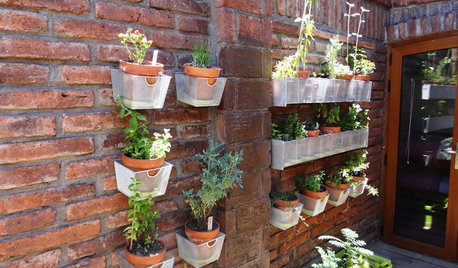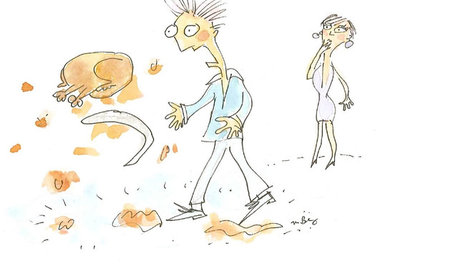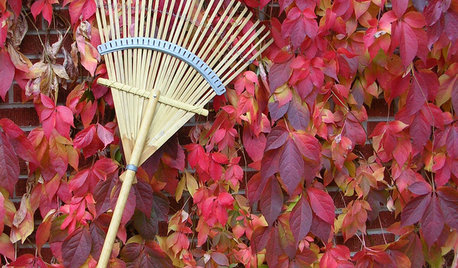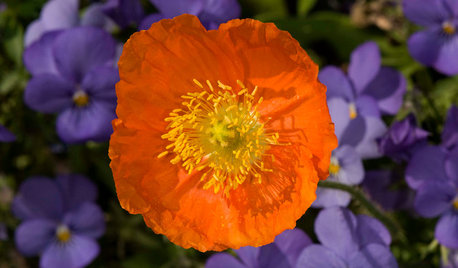Delicata squash.....how do I know it is ripe?
Folks I tried this squash for the first time, but I think I am picking it too soon. Can you tell me the best time or how to know when to pick this squash? Am I suppose to let it "sit" some place before using it? I am a very new gardener and I have never planted winter squash. I have several types in my garden even butternut and have no idea when I should pick them.
Comments (20)
opabinia51
18 years agolast modified: 9 years agoThese little gems are white with orange spots when they are ripe. It's best to raised them off the ground with some straw or some sort of structure to ensure they don't rot while maturing.
goatster
Original Author18 years agolast modified: 9 years agoFor the most part they are a cream/white color with green stripes that are fading as they age. Thanks for the tip on getting them off the ground. I may have to use some plastic coffee can lids. I have been saving them for that and thought it would work great. Thanks for responding I was afraid no one would.
carolyn137
18 years agolast modified: 9 years agoThanks for responding I was afraid no one would.
I thought about it and then asked myself why this thread was even here. LOL
Best to post questions about squash **culture**, etc, in the Vegetable Forum.
But a few hints.
If in the future you need to know what a ripe anything should look like or how to grow it, I'd do the following.
For images, go to google.com and click on the IMAGE heading and then below that type in, for instance, Delicata Squash. I did, for you, and that link is below.
As a new gardener what I'd do if I were you is to get the free copies of seed catalogs from Johnny's Selected Seeds, Stokes Seeds and Territorial Seeds.
Not only will you have pictures of all the common veggies, but more importantly, each of those three catalogs has perhaps the best info out there on culture, pest and diseases to worry about, etc.
Delicata is not the long term storing type of squash as would be a butternut or buttercup or most others. Rather fragile actually in my experience, and does tend to rot easily if stored too long.
If you need to know what "curing" of squash means and is, you can find that out thru Google as well where different links will tell you which squash benefit from it the most. Just enter curing of squash or similar at Google. Sometimes one has to play around with the words used before one gets the info looked for.
Hope that helps.
Carolyn
Here is a link that might be useful: Delicata Squash Pictures
douglas14
18 years agolast modified: 9 years agoMy experience with Delicata, is that they have stored quite well. This year we were eating them four months after harvest, until we ran out of them. They were stored in a cool room that with the door shut.
I haven't had trouble with them rotting in the garden either.
When harvesting them, I recommend cutting them (with a serrated knife or hand saw---be careful!), where the stem meets the vine. The stem can break off quite easily, where it is attached to the fruit. If the stem does break off, I'd use these squash first, as I've heard that squash without stems tend not to keep as long.
This year I'm trying Honeyboat and Sugarloaf. These are two Delicata types.Douglas
goatster
Original Author18 years agolast modified: 9 years agoThank you so much Douglas, that does help me out. I am a complete noobie when it comes to the garden. This is my first year with a really big garden AND Winter Squash. Right now the plants are huge and healthy.
harleylady
18 years agolast modified: 9 years agoDelicata are the only winter squash I like. Like Douglas, my experience is that they store quite well. We winter in Mexico and I always take cartons of them with us and they last us til we return home in the spring.
organic_amber
16 years agolast modified: 9 years agoAbout Delicata Squash - Do the green stripes on the ribbing of the squash appear later?? I'm growing the plants from seed I brought from Territorial Seed Co. The plants are producing very pale, oblong fruits, but I don't see the green ribbing like in the picture. Maybe they sent me the wrong seed? Also I was wondering if anyone has grown the fairy hybrid squash. I'm growing it now and am just wondering if it's as great-tasting as the advertisement says.
lakedallasmary
16 years agolast modified: 9 years agoWinter squash is ripe after it looks like it does in the picture on the envelope or catalog, but there are other signs of ripeness. It is not like a cucumber where you can pick when you like the size of it.
More info:
The stem attatched to the squash drys up and cracks when winter squash is ripe
The skin resists a fingernail. In other words, the skin is hard.
Winter squash can not over ripen, but will taste yucky if picked too soon, so if in doubt wait.
If the plant dies, you may as well pick the squash as the plant will not be providing it anymore nutrients. If you don't pick it, the squash borers will crawl down the vine in search of something alive to eat, which would be your prized squash.
leave 1-2" of stem on the squash.
I put a wood scrap under the squash as soon as I see it to prevent rotting.
If a frost is predicted, you can cover the whole squash plant or you could pick the squash and let it continue to mature on the counter. Depending on the state of ripeness and size of the squash, it could take a month or more to ripen. I let mine cure for months since I think they just taste better.
Do not put them in the frig (ripe or not). This will make them spoil sooner. They say store them at 50 degrees, but I store them on the counter. I believe the Indians used to store them underground, so a cool root cellar would work.
Small, immature squash will rot before they ripen. If you are not sure if they are big enough, set them on the counter, but toss them in the compost pile if the begin to leak or rot.
I have read to eat the delicata and sweet dumpling types first, but they do last for months on the counter.
Eat squash with missing stems or bruises first. If wounds have healed, then they should be ok to store.
Squash needs to be cured at 75-85 degrees about 10-14 days at least before eating. Cured squash will last longer and taste sweeter. I have had a green jack-o-lantern sized pumpkin turn orange in the period of 1 month on the counter.
Here is a good page on squash
This is a fine forum to ask about growing heirloom vegetables. I wish there was a separate forum for heirloom flowers.
organic_amber
16 years agolast modified: 9 years agoLakedallasmary - Thanks so much for the info! this is the first year I've grown squash and I knew nothing about curing. I was just going to pick the squash and fix it the same day! Your tips are very helpful.
debbieisbell
16 years agolast modified: 9 years agoAmen,ruthieg.I've felt like that so often,and have even"discussed" this with her at one time,but to no avail.I even quit posting for a while,just to bite my tongue,but now I just ignore her and skip her posts.
lakedallasmary
16 years agolast modified: 9 years agoIf the squash is completely ripe and it is an acorn, sweet dumpling or delicata you could cook it the same day. The literature say that acorns, and delicatas do not need to be cured. But I find them sweeter if cured. If cooking the same day, it may need some sugar to help them out.
The first time that I grew squash it was not on purpose. In 2004, I tossed some squash innards out in the flower bed out front as I thought the natural fertilizer would be good for the soil, plus best to keep decomposable stuff out of the landfill. It never occurred to me they would sprout. It was fun to watch them grow. I did not take care of them and let them do their own thing. I think they did well since it was on the north east side of the house and in Texas afternoon shade is a very good thing. I was so excited to see about 5 ripe acorn squash. I picked them all. I sliced one in half, and to my surprise, the squash did not seem like the correct color. I cooked it anyway. It did not taste good. I tossed the rest of the unripe squash out side under a large bush. Moral of this story, if you do not know if something is ripe, don't pick them all!
This experience was so much fun, I decided to garden on purpose. In 2005, on the west side of the house, I planted sugar pumpkins and buttercups. I planted them in spring. All the squash died of the dreaded squash borer, but the sugar pumpkin did great. When the pumpkins turned orange, I picked them all. They tasted horrible. Here is another opportunity for a moral. First, if you messed up the first time, figure out why, and don't keep picking unripe squash! Oh yes, and don't pick them all. The other moral is, in Texas, full sun does not really mean, full sun all day! I moved my garden from the south west back side of the house which gets hot afternoon sun to the south east side of the house which gets shade after 2-3 pm depending how far away from house the bed is.
I looked up how to figure out when winter squash are ripe. So geared up with that info,. I tried again for a fall harvest.
Again, I planted buttercup and sugar pumpkin. This time, all the sugar pumpkins died due to heat, and lack of water. I somehow had the idea plants can take care of themselves. This is probably true, but not if you are growing them out of their native area, and not if your area is in an extreme drought as we were. Another moral, squash need to be watered, especially if one lives in Texas.
The buttercup still got squash borer, but survived it. I think this is because in Texas fall crops just plain do better. Fruit has an easier time maturing in cool fall verses our inferno of a summer. The other reason I believe they did better was because, I did not yank them up when they got borer. I put soil over the vines in many places to encourage rooting. If the main plant dies the place beyond the new root should survive. Also, warm weather crops if planted in cool damp soil will get more critters. The critters are nature's way of eliminating sick plants so they will not make it to maturity, make seeds, and thus make more sick plants. If a plant gets critters, it is not suffering a pesticide deficiency.
The usual problems are,
Seed planted when soil is too cool, too wet, or just plan wrong time of year. I just read someplace that seeds started in a relatively dry soil do better. Spring growth is often sappy.
Selecting the incorrect variety for your area. Believe me, planting seeds from northern catalog, sets a Texas gardener up for failure. I now select varieties listed in the seed savers exchange yearbook by southern gardeners. When purchasing catalog seeds, I select viney verses bushy crops. Seed catalogs try to be as vague as possible so they dont discourage folks from regions that certain seed varieties canÂt possibly do well, from wasting money on their seeds. For example California blackeye pea which is a bush plant, did very poorly. Texas longhorn cowpea, which has a 7 foot vine, did not seem to be bothered much in last year's drought. Baby blue hubbard which is bushy, died of borer. Anna Swartz hubbard has a long, long vine, did great. I believe this is because, deep roots come with a plant with long vines. I believe deep roots will help a plant survive extreme rain and frost better too. The roots go below the level of the wet, dry, hot or cold soil. We have been dumped on this year in Texas by lots and lots of rain. My pole beans did just fine. The leaves of the bush beans got full of holes. I won't be planting beans in spring anymore though. They don't have time to make many beans before it just gets too hot.
Planting root crops in spring verses fall. Spring weather encourages seed development, and leafy growth verses root growth.
Planting too close together. You know when someone stands too close to you, you feel like they are in your space, I think plants must feel that way too. It can be surprising how deep and wide roots grown. On this site, root development of vegetable crops, they show how deep the roots grow. If you don't have time to read the text, just scroll down to see the pictures. After reading this site, I often about double the suggested seed distances.
Watering too much. I live in Texas, so in the heat of summer, I might see plants suffering from heat stress, but rarely see a bug. I usually only see bugs, when rain is more frequent (like spring and fall), or I goof up and water too much. "I believe" city water can kill beneficial microbes on the surface of the leaves; so I avoid getting foliage wet when hose watering. " I think" this is the reason rain does not seem to bother leaves like city water can. Plus when it rains, it tends to be cloudy, which protects the leaves from scorching. If you water too much the surface soil says wet so the roots have no need to go deep in search of water. Deep roots protect the plant in times of extreme weather.
I could go on with things like this but I am way off topic.
Personally, I think that squash grow better amongst the grass and weeds. I have seen volunteer squash in the back yard do way better than in mulched beds. The plants get more shade from the grass and have blades of grass to grab on to. I have observed a much greater harvest in my English peas when grass poked through thinning mulch verses mulched beds with no grass. I have taken soil temps in various circumstances. The soil is warmest in bare soil. It can be 5-10 degrees cooler in mulched soil. In beds where there is a living mulch of weeds and grass, it can be 3-5 degrees cooler than even the mulched beds. In Texas, this is a good thing. So moral here is, I plant squash on the edge of the beds and let the squash jump over the edge and wander around in the yard.
Oh yes, one more thing to note. Last fall, I planted squash close to the house, as squash tend to wilt if there get too much Texas sun. That was something that I will never do again. The garden is on the south east side of the house. Squash like to grow toward the sun, so they grew out into the rest of the garden covering everything: my fall planted root crops, bush beans peas, and my tomatoes. They ran amuck! Moral here: Do not let your squash, squash your garden. Either grow them up a trellis or do like I do and plant them on the far edge and let them grow toward the sun, in my case east, away from the rest of the plants. Bush squash will tend to grow out in shorter distances in all directions, so give them room.
I hope some of this helps out.
lakedallasmary
16 years agolast modified: 9 years agocorrection to above post
The site said seeds state out better in moderately dry soil not relatively dry.
The other thing is I said bush squash will grow out in shorter distances in all directions. I was thinking of the semi bush plants like delicata and sweet dumpling. These grow vines but shorter, and grow in all directions. I find them annoying since I can not predict what they will do.
Bush squash have stems from a central core and do not vine out.
west_texas_peg
16 years agolast modified: 9 years agoThis year I swapped for Delicata squash seeds and now have some very long vines with large squash, much larger than those in the photos, no green stripes and is oblong--not peanut shaped.
It definitely is not a bush type, one vine has a runner about 15 feet long and is still growing about a foot a day. There are other runners 10 or more feet.
Mildew hit the plant and I took off the worst of the leaves.
The squash is already larger than the ones I see in photos online. I was so glad to see this thread since I have no idea how to tell when they are ripe.
I know on watermelon you pick when the curlicue near the melon dries up. Today I found a very nice sized yellow icebox watermelon that was hiding under a lantana. Unfortunately it is not ready yet. We have been eating these this summer so am excited to see more coming on the vines.
Any further info on when to harvest the Delicata will be appreciated.
Peggy
hoodat
13 years agolast modified: 9 years agolakedallasmary - Pesticide deficiency? I almost fell out of my chair laughing when I read that.
I usually wait till my Winter squash vines are showing a lot of yellow or dying leaves. That tells me the vines have done their thing and the squash are ready to go. Often I wait till the main stem has shriveled where it enters the soil. It's so tempting to pick the squash too ealy so I just let the vines tell me when.ginainthegarden
13 years agolast modified: 9 years agoWow, well I feel a little silly! I have been harvesting these squash and eating them for the last several weeks! They have a wonderful mellow flavor, and we sauteed them with some summer squash and onion. The packet said they were winter, but the vines are loaded with them and still growing! If they are supposed to sit all summer, they will overrun my garden for sure.
I thought they were ripe because they were pale with the green stripes. They also practically fall off the vines if you pick them up.
This is my first time to grow winter squash as well, and apparently I have a lot to learn! Is there a problem with eating these early? They certainly taste good! They are not like the acorn or butternut that taste terrible if picked early.weyrcat
13 years agolast modified: 9 years agoHi! Sorry to pop in: Can these Winter Squash BE trellised? My seed packet (for the little cream ones with green stripes) says "Sugar Dumpling" (from High Mowing Seeds), but they seem to be the same ones. If I train them to trellis, won't they get too heavy and snap off? O_O
voodoodaul
13 years agolast modified: 9 years agoHere's what you can do, if you realize you didn't give your butternuts enough time to ripen...
1) Put paper towel down on your window sill.
2) Place your squash "stem up" so they sit nicely and can get enough sun.
3) Take additional paper towel (about 1 piece for every stem you have), wet it, and wrap it around the cut-off stem. Try to do this as soon as possible after cutting your squash off the vine. Also make sure most of the paper towel is where the stem is cut off.
4) To make sure it stays damp, take a piece of foil (I used pieces about 3-4" squared) and gently place it on top of the paper towel that is covering the stem of the butternut...making sure to pinch it tightly around the part of the stem that is closest to the fruit (so the foil should resemble the shape of a light bulb). Make sure the foil completely covers the paper towel.
5) Repeat every day, for about a week (or less if your stems happen to get mushy, mine didn't), to ensure they're getting enough water to keep them ripening.
TAH DAAAAAAAAAAH! Brilliance at it's best.
Thank you.
(I made this up, and tried it, and it completely works!)Nicole_Platte_gmail_com
12 years agolast modified: 9 years agoCarolyn did nothing wrong here! Please avoid flaming people on the Internet. If you do not know what that means, go google it!
Cherie Antin Fasbinder
7 years agoI wouldn't call myself an expert gardener, but I've learned a lot over the past 15 yrs gardening - and still learning! I like to try some new things every year. One of the things I tried this year is the Delicata. For the person who asked about growing on a trellis... I had read a bit on vertical growing a couple years ago and did it last year & this year. Used a garden arch for all my winter squash, small watermelon, honeydew, and cantaloupe. It works great and allows me more room in my garden for other things! You do need to train the vines to wrap around the trellis. Then as far as the weight of the fruit... it looks pretty silly, but works like a charm... when the fruits get about the size of my fist, I take a knee-hi hose, tie in a knot around one of the wires on the trellis and make a hammock support for the fruit. My hubbie teases me about how silly it looks... but it works perfectly to support the weight so the fruit does not come off the vine until I'm ready for it to! Growing on a vine also eliminates the problem of rotting on the ground.

















ruthieg__tx